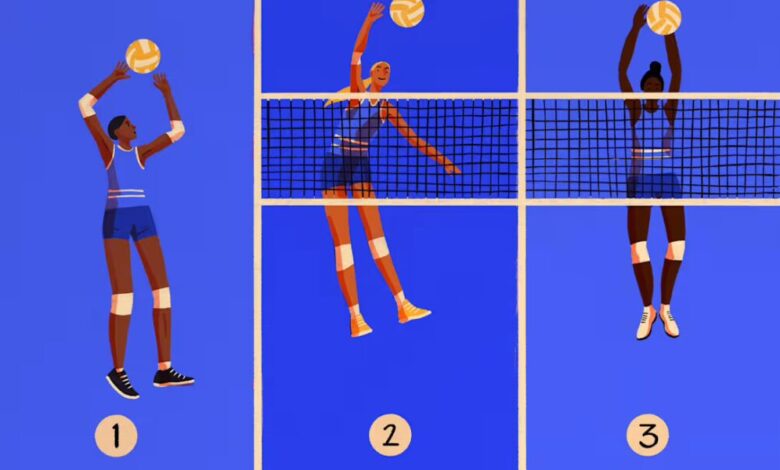Who Plays Where on the Court

Six players rotate around the court, but they’re not randomly placed. Each spot has a purpose, each player has a role.
Here’s what confuses newcomers: “position” means two things in volleyball. It’s where you stand – zones numbered 1 through 6. And it’s your specialized role – setter, hitter, blocker, or libero.
Get both concepts and the game suddenly makes sense.
Court Zones
Six zones, numbered clockwise from back right. Position 1 is back right corner. Position 2, front right. Position 3, middle front. Position 4, front left. Position 5, back left. Position 6, middle back.
Three players front row, three back row. Win a rally after receiving serve? Everyone rotates clockwise one spot.
The 10-foot line splits the court horizontally. Back-row players can’t attack above the net if they’re in front of this line. They jump from behind it.
Setter: Running the Offense
VolleyballMag.com explains that setters touch the second ball each rally, distributing to teammates in scoring position.
They defend from position 1, attack from position 2. Need quick thinking, accurate hands, leadership. Good setters read defenses, find weaknesses, exploit them.
Speed is everything. Must reach every second ball wherever it lands. Use hand signals to call plays before serves.
Outside Hitter: The Workload
Outside hitters do everything. Hit from the left side in position 4. Pass serves, play defense, block, attack from front and back rows.
Many stay in for all six rotations because they’re versatile. Need jumping ability and stamina – they’ll hit more than anyone else. Teams lean on them when plays break down.
Middle Blocker: The Wall
Middle blockers own the net. Play position 3, usually the tallest players on the team. First line of defense against opponent attacks.
Hoover Met Complex notes they also run quick attacks in the middle. Fast-tempo plays catch defenses sleeping.
Most teams sub them out in back row. A libero enters, upgrading defense.
Opposite Hitter: Right Side Power
Play on the right side, always diagonal from the setter. That’s where the name comes from.
Need power hitting and blocking skills. Get lots of attacks, especially when the setter’s front row and can’t hit. VolleyballXL says opposites are often the strongest pure hitters.
Less passing responsibility than outside hitters. Focus on offense and blocking.
Libero Volleyball: Different Jersey, Different Rules
Spot the libero immediately – different colored jersey. This specialized position changed volleyball when it debuted in 1998.
NCAA.com breaks down the rules. Strictly back-row. Can only be replaced by the same player they subbed for. Replacements don’t count toward the team’s 15 subs per set.
Can’t attack above the net. Can’t overhead set from in front of the 10-foot line if a teammate will attack that set. Can’t serve in most international play, though NCAA allows it.
What they can do? Everything defensive. Pass serves, dig spikes, keep rallies alive with spectacular floor defense. Usually shorter, quicker players with exceptional ball control.
Most teams use their libero to replace middle blockers in back row. Instant defensive upgrade.
Defensive Specialist
Similar to liberos but wear regular jerseys. Their subs count toward team limits. Can play front row if needed.
Coaches use them strategically. Better passer against a tough server? Bring in the DS. Need stronger defense at a crucial moment? DS time. Some teams sub in excellent servers just to win points on serve.
How It Works Together
At dbbet-bangladesh.com, fans follow volleyball and see how these positions on court interact during real matches.
Specialization creates efficiency. Setters distribute. Outside hitters attack everywhere. Middle blockers read and block. Opposites unleash power. Liberos master defense.
Rotation forces everyone through different zones, but specialized roles stay constant. An outside hitter still attacks left side whether in position 4 or rotating through back row.
Teams roster 10-14 players with at least two per position. Allows substitutions and tactical options.
Rotation Rules
Players rotate clockwise to the next position. But they don’t stay in those exact spots after the serve. They shift to optimal positions on court while following overlap rules.
Overlap rules keep order. Back-row players stay behind front-row players at serve. Right-side players stay right of their neighbors. Break these rules? Rotation violation, point to the other team.
After serve contact, players move anywhere. Setters sprint to position 2. Outside hitters shift to position 4. Court transforms from rotation formation into game formation.
Why This Matters
Understanding volleyball positions makes watching better. You’ll notice weak rotations – setter front row with fewer attack options. Or when a libero volleyball player makes a dig nobody else could reach.
Rotation keeps volleyball balanced. Without it, teams would park their best players in perfect spots all game. Rotation forces adaptation, creates strategic depth.
Different positions on court need different attributes. Tall blockers become middle blockers. Quick athletes with ball control become liberos. Versatile athletes who do everything play outside hitter.
Coaches build around their personnel. Exceptional setter? Run faster offense. Dominant opposite? Feed them more sets. The framework stays consistent, but usage varies enormously.
Getting Started
New to volleyball? Watch positions on court shift after each serve. Notice the libero making diving saves. Track setters moving to every second ball. See middle blockers reading attack patterns.
There’s a role for different body types and skills. Don’t need to be 6’5″ to contribute – liberos prove defensive wizardry matters as much as power hitting.
Youth players try multiple positions before specializing. Helps them understand the whole game, find where natural talents fit. Even pros sometimes switch positions as skills develop or team needs change.
Volleyball keeps evolving. The libero only joined in 1998 but now feels essential. Rules keep changing to make games faster and more exciting while maintaining core strategy.
Whether watching Olympics, college matches, or club tournaments, positions on court create the framework that makes volleyball work. Six players, six zones, unlimited possibilities.





